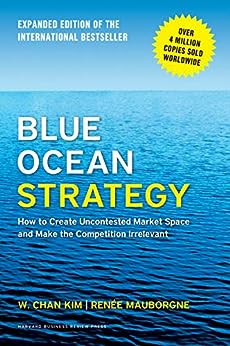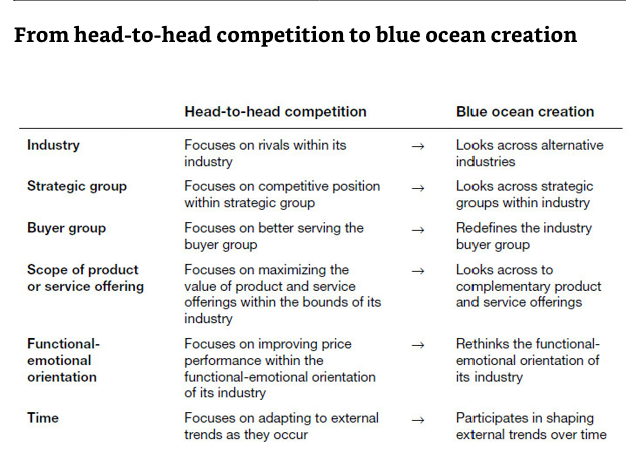Blue Ocean Strategy
The main idea of this book is to get out of a red ocean of bloody competition and into a blue ocean of uncontested market space characterized by new demand and strong profitable growth.

What is the Blue Ocean Strategy?
A shift from competing to creating new market space and hence making the competition irrelevant.
Blue oceans are defined by untapped market space, demand creation, and the opportunity for highly profitable growth. Although some blue oceans are created well beyond existing industry boundaries, most are created from within red oceans by expanding existing industry boundaries. In blue oceans, competition is irrelevant because the rules of the game are waiting to be set.
- Competition should not occupy the center of strategic thinking.
- The aim is not to outperform the competitors, but to offer a quantum leap in value that makes the competition irrelevant.
- Industry structure is not given; it can be shaped. A red ocean need not stay red.
- Strategic creativity can be unlocked systematically.
- Execution can be built into strategy formulation.

Value Innovation
You don’t want innovation without value.
The cornerstone of Blue Ocean Strategy. Create a leap in value for buyers and your company, opening up new and uncontested market space.
- Which of the factors that the industry takes for granted should be eliminated?
- Which factors should be reduced well below the industry’s standard?
- Which factors should be raised well above the industry’s standard?
- Which factors should be created that the industry has never offered?
Reconstruct Market Boundaries
The first principle of the blue ocean strategy is to reconstruct market boundaries to break from the competition and create blue oceans. The challenge is to successfully identify, out of the haystack of possibilities that exist, commercially compelling blue ocean opportunities.
To break out of red oceans, companies must break out of the accepted boundaries that define how they compete.
Red Ocean Traps
- Define your industry similarly and focus on being the best within it
- Look at their industries through the lens of generally accepted strategic groups (such as luxury automobiles, economy cars, and family vehicles), and strive to stand out in the strategic group they play in
- Focus on the same buyer group, be it the purchaser (as in the office equipment industry), the user (as in the clothing industry), or the influencer (as in the pharmaceutical industry)
- Define the scope of the products and services offered by their industry similarly
- Accept their industry’s functional or emotional orientation
- Focus on the same point in time — and often on current competitive threats — in formulating strategy.
Look Across
Alternative Industries. What are the alternative industries to your industry, i.e. Software Development? Why do customers trade across them?
Strategic Groups within Industries. What are the strategic groups in your industry? Why do customers trade up for the higher group, and why do they trade down for the lower one?
Chain of Buyers. Most competitors think there’s a single target buyer. In reality, there is a chain of “buyers” who are directly or indirectly involved in the buying decision. For example, there are influencers, there are purchasers, and there are users.
- Challenging an industry’s conventional wisdom about which buyer group to target can lead to the discovery of a new blue ocean.
- By looking across buyer groups, you can gain new insights into how to redesign your value to focus on a previously overlooked set of buyers.
- What is the chain of buyers in your industry? Which buyer group does your industry typically focus on? If you shifted the buyer group of your industry, how could you unlock new value?
Complementary Product and Service Offerings. What is the context in which your product or service is used? What happens before, during, and after your product or service is used? Can you identify the pain points? How can you eliminate these pain points through a complementary product or service offering?
Functional or Emotional Appeal to Buyers. Does your industry compete on functionality or emotional appeal? If you compete on emotional appeal, what elements can you strip out to make it functional? If you compete on functionality, what elements can be added to make it emotional?
Time. By looking across time—from the value a market delivers today to the value it might deliver tomorrow - you can actively shape their future and lay claim to a new blue ocean.